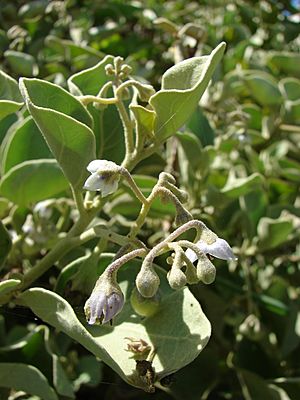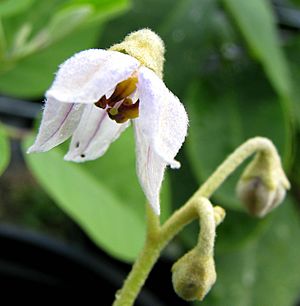Solanum nelsonii facts for kids
Quick facts for kids Solanum nelsonii |
|
|---|---|
 |
|
| Conservation status | |
| Scientific classification | |
| Genus: |
Solanum
|
| Species: |
nelsonii
|
| Synonyms | |
|
See text |
|
Solanum nelsonii, also called pōpolo or Nelson's horsenettle, is a special plant found only on the Pacific Islands. It's a type of plant that lives for more than two years, like a small, spreading bush. This plant is part of the nightshade family, called Solanaceae. It can be found growing close to the ground in sandy areas near the coast.
This plant is considered poisonous, so it's important not to eat it. On September 30, 2016, the U.S. Fish and Wildlife Service officially listed Solanum nelsonii as an endangered species. This means it's a plant that needs special protection to keep it from disappearing forever. Pōpolo is used in projects to help bring nature back to life in Hawaii and the Northwest Hawaiian Islands.
About Pōpolo
The plant Solanum nelsonii was first described by a scientist named Michel Félix Dunal. Scientists give plants and animals a special two-part name, called a scientific name. This helps everyone around the world know exactly which plant they are talking about.
Sometimes, the name Solanum nelsonii was mistakenly given to other plants. For example:
- A plant called S. nelsonii by Zipp. is actually S. violaceum.
- Another plant called S. nelsonii by Correll is actually S. oxycarpum.
Scientists have also described different types of Solanum nelsonii, called varieties. However, these varieties are not usually seen as separate types anymore.
Why Pōpolo is Important
Pōpolo is a native plant to the Pacific Islands, meaning it naturally grows there. It plays a role in its natural environment. Because it is endangered, people are working hard to protect it. Using pōpolo in restoration projects helps to bring back native plants to areas where they might have been lost. This helps to keep the natural balance of the ecosystem.
See also
 In Spanish: Solanum nelsonii para niños
In Spanish: Solanum nelsonii para niños



